BMW’s only Le Mans win: the dramatic 1999 triumph of its V12 LMR
The German giant returns to Le Mans 25 years after it last conquered the circuit. Gary Watkins recalls a hare and tortoise story
DPPI
It wasn’t an auspicious start. Less than an hour into BMW’s 1999 Le Mans 24 Hours campaign at the pre-event test one car was parked in the barriers, the other two were ensconced in the pits and wouldn’t leave until a couple of hours into the afternoon session. The German manufacturer, back at the French enduro for a second crack with a Le Mans Prototype, didn’t look like a potential winner. Not with Toyota, Mercedes, Audi and Nissan ranged against it in a year that until the present era stood as the high-water mark in manufacturer participation at the front of the field. Yet six weeks later, BMW was celebrating a dramatic victory after a back-and-forth battle with the first named of those opponents.
One of the three new V12 LMRs designed, built and developed by Williams and run by the Schnitzer Motorsport squad had crashed minutes into the first of the two sessions of what was then known as pre-qualifying — not everyone on the entry went forward to race weekend. It wasn’t initially clear why Yannick Dalmas had crashed at the Indianapolis sequence. Or rather it wasn’t understood what had caused the loss of the rear wing, which resulted in him spinning wildly through the quick right-hander. Until it was — and a fix made — the remaining Bimmers wouldn’t be back on track.
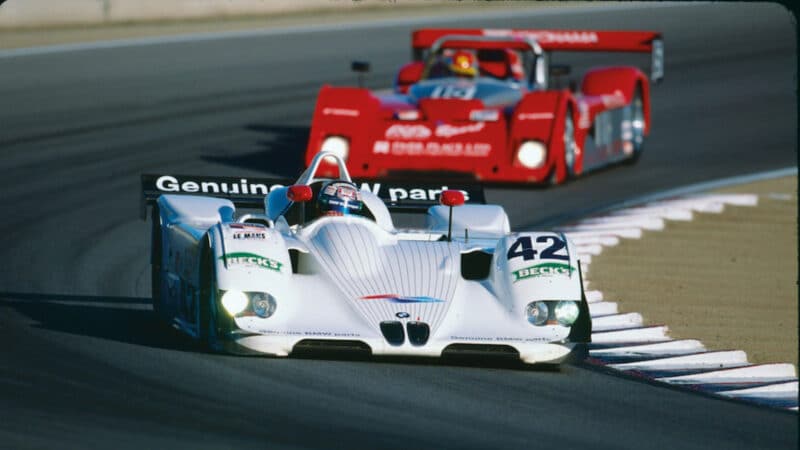
Victory came for BMW’s V12 LMR at the Sebring 12 Hours in March 1999.
McKlein
BMW bounced back from this faltering start, just as it had a few months before at the Sebring 12 Hours. Its victory in the opening round of the American Le Mans Series proved that adversity could be overcome, and in double-quick time. Days before the start of the meeting, the BMW trucks were parked a couple of hundred miles to the south in Florida. The drivers who’d just finished a test at Homestead had gone to bed in the belief that they would be heading east by aircraft back to Europe rather than north by car up to Sebring. They were counting without the resourcefulness of the engineers at Williams and its transmission partner, Xtrac.
A problem with the differential housing had resulted in the test finishing early, even after modifications had been made on site. There was nervousness in the camp after the previous year’s debacle at Le Mans: a wheel-bearing problem had resulted in an early bath for the drivers of the two V12 LMs, the first stab by Williams at an LMP powered by BMW’s S70 V12 that already had a victory at the 24 Hours to its name in McLaren’s F1 GTR in 1995.
“It was actually an uncomplicated, elegant engineering solution,” says Graham Humphrys, lead designer on the V12 LMR under project chief John Russell. A strengthened diff casing was already in the pipeline when Gerhard Berger, installed the previous year as boss of BMW Motorsport, called Williams technical chief Patrick Head to talk about the prospects of Schnitzer making the race.
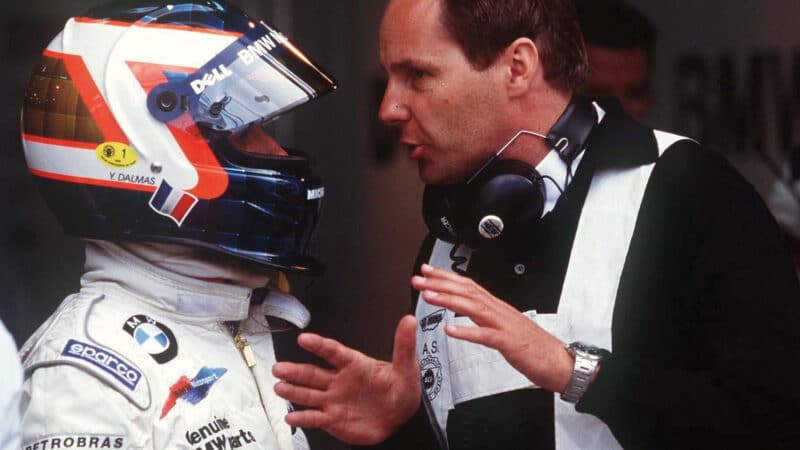
“Push!” Gerhard Berger tells Yannick Dalmas at Le Mans ’99
Getty Images
“The BMW people got a bit wobbly and were weighing up whether we should go on to Sebring,” continues Humphrys. “They phoned Berger, who then phoned Patrick. He told Gerhard that it wasn’t a problem: John, who was back at base, had already instigated an upgrade. Xtrac did an amazing job. John flew out with the new parts and we fitted them in the paddock.”
“There was definitely a nervousness after what had happened at Le Mans the year before,” recalls Tom Kristensen, who’d joined BMW in ’98. “When we went down to breakfast with our bags packed in our humble little hotel, they told us that we would be going to Sebring after all! They had to get our rooms back at the even more humble hotel there.”
Kristensen would go on to score the first of his record six victories at Sebring. He prevailed aboard the car shared with JJ Lehto and Jörg Müller in a close fight with the best of Dyson Racing’s Ford-powered Riley & Scott Mk IIIs. The winning margin was just nine seconds.
Twelve hours at Sebring, goes the adage, is equivalent of 24 hours at Le Mans. It didn’t look that way early on the test day. The aerodynamic forces encountered on the high-speed Circuit de la Sarthe were higher than those at Sebring and the venues for its development testing. The official line on the day was that a bodywork catch had come undone. Not quite a lie, it definitely wasn’t the full explanation.
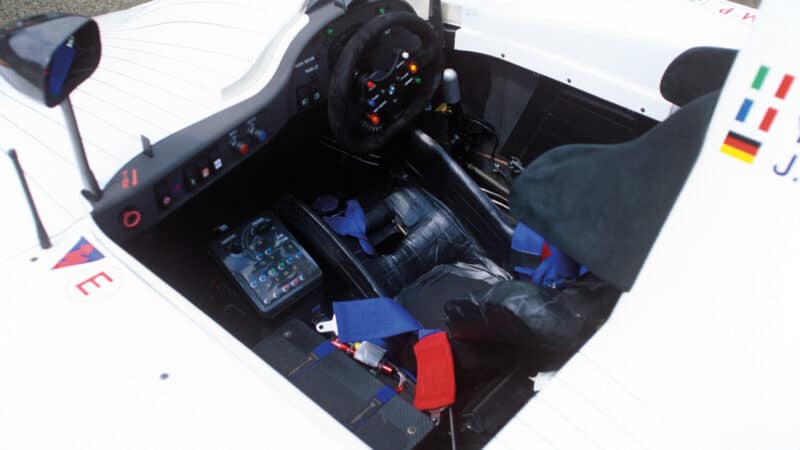
Note the battery ‘step’ in the footwell, allowing a quicker changeover of drivers
A catch or catches had come loose, but only because the transverse beam to which a row of three at the back of the engine cover was flexing. This carbon-fibre component carried the loads from the rear wing endplates to the gearbox. The catches had pulled out at the fastest point on the circuit on the run from Mulsanne Corner to Indianapolis and the deck flew off, taking the wing with it.
“The telemetry data showed that the wing went AWOL at over 200mph”
The result was a heart-in-the-mouth moment for Dalmas, already a three-time winner at Le Mans with Peugeot, Porsche and McLaren. “A big shock,” is how he describes it 25 years on. The telemetry data showed that the wing went AWOL at over 200mph (the figure quoted at the time in kmh was 328). Another surprise was that Dalmas avoided hitting anything.
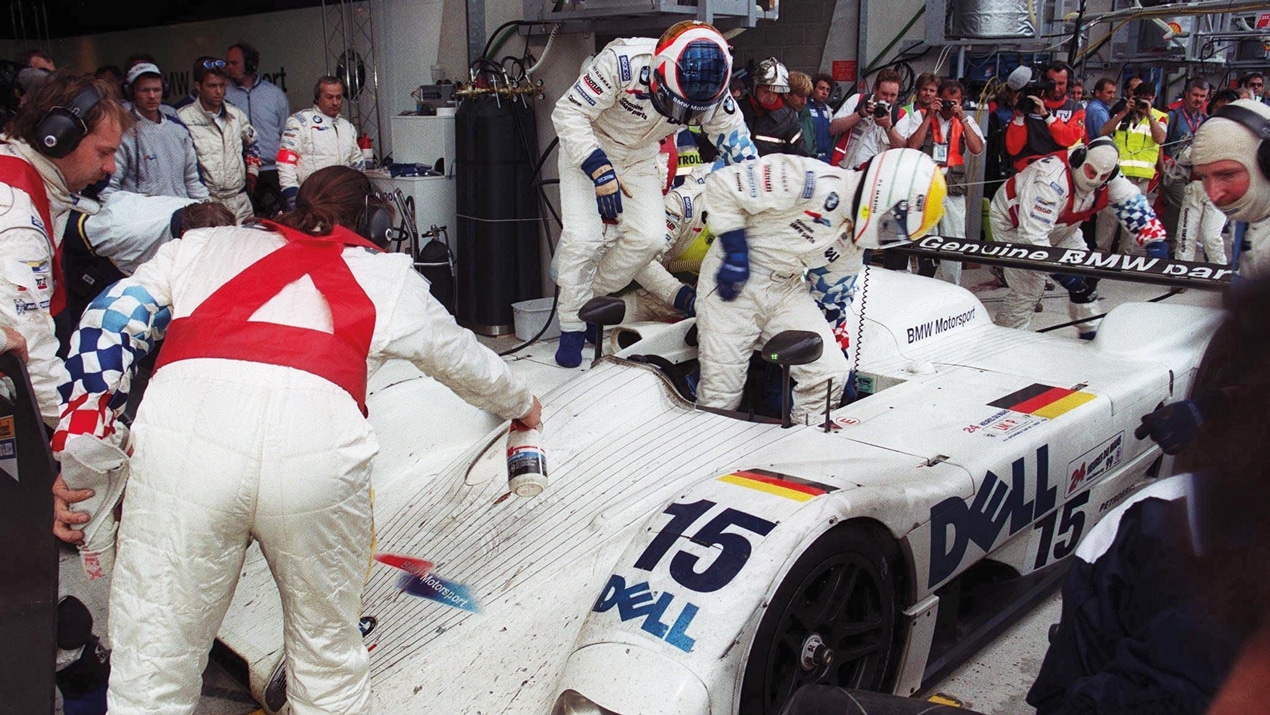
“I made a 360 without touching the guardrail on the left or the right,” recalls Dalmas. “The gods were with me. There wasn’t a mark on the car.”
But the V12 LMR did sustain damage, as did Dalmas’s diminutive frame. The car’s trip over the kerbs at high speed broke both a front suspension mounting and one of its driver’s ribs. This particular BMW wouldn’t run again that day because the broken insert couldn’t be extracted from the survival cell, but Schnitzer and Williams did manage to get its other two cars out when it was their turn in the afternoon thanks to a Heath Robinson repair in the field. The beam was strengthened with carbon sheeting, which was bonded in place and the fix cured in the tyre ovens.
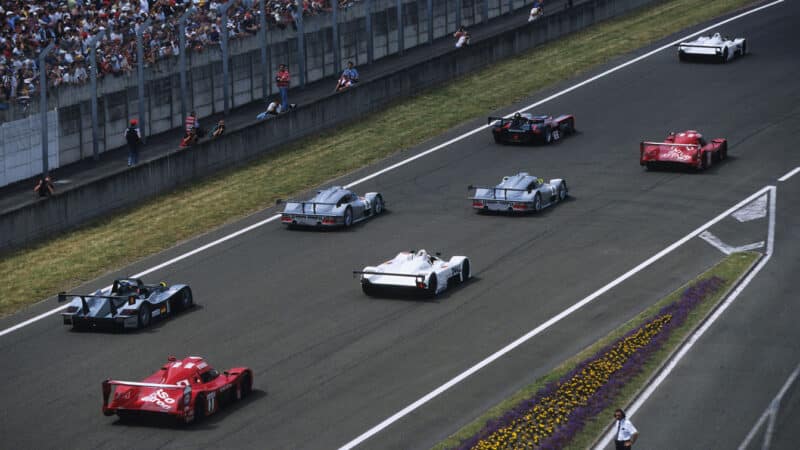
BMW was up against stiff competition at La Sarthe in ’99 – including Toyota, Audi, Mercedes and Panoz
“It was a victim of the F1 and corporate worlds coming together”
When the remaining Bimmers did get out, they were quick. Lehto ended up third in the afternoon session and fourth in the combined times, behind two of Toyota’s GT-Ones, with Martin Brundle and Ukyo Katayama at the wheel and the front-engined Panoz LMP1 Roadster S driven by David Brabham. The impressive bounce-back by BMW included a perhaps more significant time from Kristensen in the other car. He ended up sixth (and seventh overall) on race tyres. BMW looked like it would be more than in the mix going into the race in June. That hadn’t been the case 12 months previously. The V12 LM was a rush job by a group that didn’t appreciate the nuances of endurance racing. Worse still, BMW’s styling department got involved. “It was a victim of the F1 and the corporate worlds coming together,” says Humphrys. “That’s not what you want for Le Mans.”
Steve Soper, one of the drivers in year one, is more forthright: “It was a shitbox.” The new car, he adds, was “not an evolution but a revolution”. A clean-sheet of paper design that carried over little more than the engine was the result of Humphrys’ arrival post-Le Mans at Head’s behest.
“All the people on the design side at Williams were the same, so all I did was to give them the benefit of my experience and point them in the right direction,” says Humphrys, a veteran of Spice Engineering, a multiple class winner in the Le Mans 24 Hours. Second time around Williams “just kept it simple”, he says.
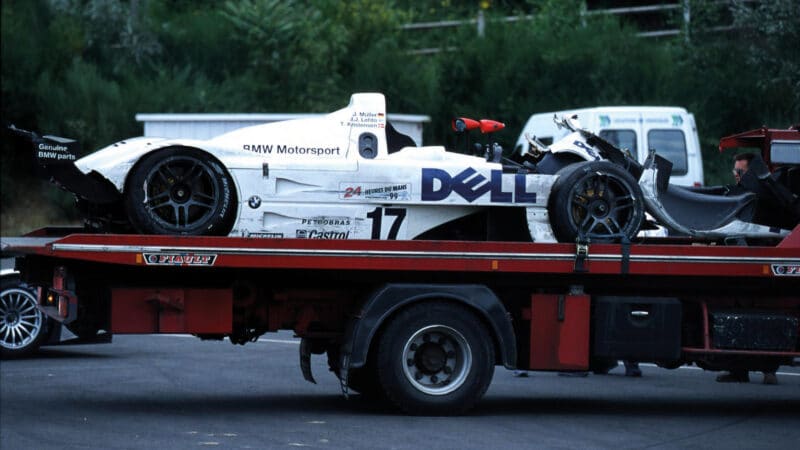
BMW led for much of the race with the faster of two V12 LMRs driven by Tom Kristensen, Jörg Müller and JJ Lehto; it lasted for more than 300 laps.
DPPI
There was one radical departure on the V12 LMR, however. A clause in the rules was spotted by Russell that allowed for a single-seater rollhoop behind the driver. The gains were marginal, but it set a design tone in prototype racing for years to come.
Humphrys’ philosophy was to create a raceable and serviceable machine. Stylist Peter Stevens, who was brought in to provide input into the car’s looks without compromising performance this time, remembers a conversation between the designer and Head concerning the size and weight of the box in which the battery sat in the ‘passenger’ footwell.
Patrick came in and said, ‘What’s that? It looks like someone could stand on it!’” remembers Stevens. “Graham’s response was, ‘That’s the idea!’ He wanted to give the driver getting out of the car somewhere to stand when he was helping to belt up the one climbing in.” Head’s response? “Bloody marvellous!”
The raceability proved central in the battle that raged between the two-car Schnitzer BMW squad (the third fielded at the test was never due to race) and the trio of GT-Ones run by Toyota Motorsport GmbH for much of the 24 hours. Or rather the two battles. First off, the Kristensen/Lehto/Müller car fought it out with the Toyota shared by Allan McNish, Thierry Boutsen and Ralf Kelleners.
“I remember Thierry getting into the lead and buggering off at one point, but we were slow in the pits,” remembers McNish. “The team hadn’t competed since Le Mans the year before, remember, but the guys got faster and faster through the race.”
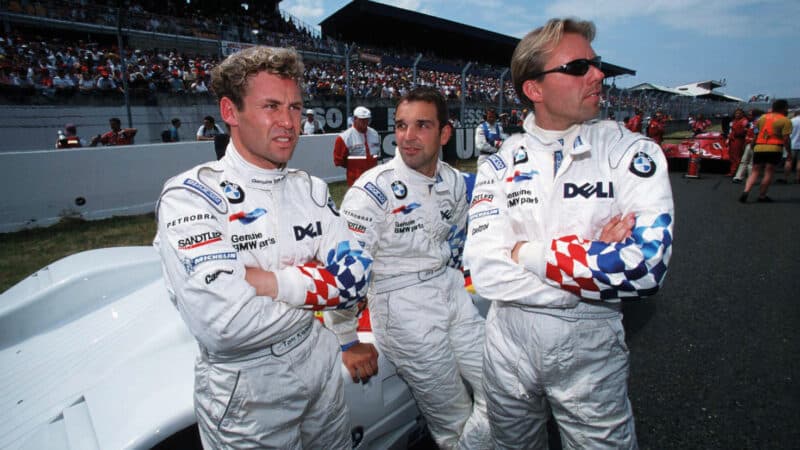
From left, Tom Kristensen, Jörg Müller and JJ Lehto
DPPI
It wasn’t quite as simple as that. Overheating injectors resulted in a delay in restarting the Toyota’s twin-turbo V8 engine almost every time. And then there was Schnitzer’s prowess under famed team manager Charly Lamm.
The Bavarian racing operation was just quicker in the pits. What’s more the LMP car went a lap further on a tank of gas than a car developed to the new LM-GTP regulations that had replaced the old GT1 ruleset for 1999.
The initial BMW vs Toyota battle came to a dramatic and early end in the small hours on Sunday. Boutsen was leading when he was punted into the wall under braking for the Dunlop Chicane by a GT car. The Belgian sustained serious back injuries and would announce his immediate retirement, already planned for the end of year, from his hospital bed.
BMW now looked home and dry. The Kristensen car led by three laps, with the second Bimmer driven by Dalmas, Pierluigi Martini and Jo Winkelhock following it up three laps in arrears. The Toyota that Brundle had put on pole had retired in the night, but the remaining GT-One with the all-Japanese line-up of Ukyo Katayama, Toshio Suzuki and the Keiichi Tsuchiya was just behind Dalmas and co in third. Mercedes was long since out of the race after withdrawing its remaining car after Peter Dumbreck’s aerial incident, the marque’s third of the event. Audi, meanwhile, was nowhere near the pace and Nissan never looked in the game.
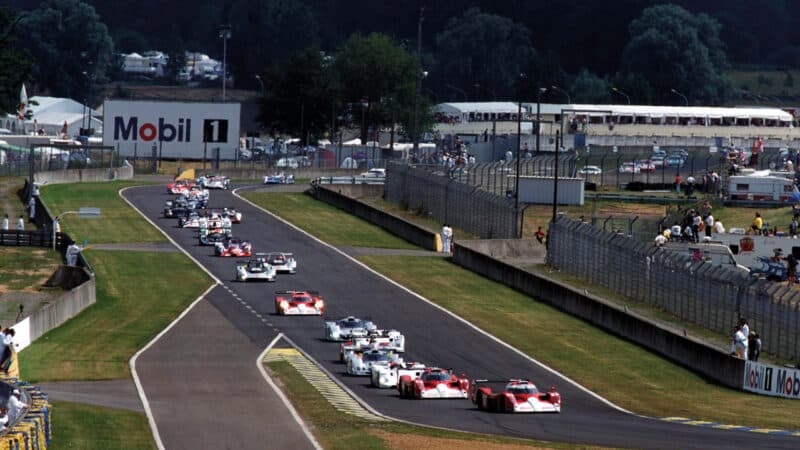
Toyota had the quicker cars in the battle out at the front
BMW’s safety margin disappeared in the 21st hour with a problem of the freakish kind. The top of a rear damper wound itself off, the corner sat down in the Porsche Curves and Lehto headed for the wall. It didn’t help that part of the front anti-rollbar mechanism fell down as the front rose and jammed the throttle open. The BMW was out of the race on the spot.
“After that I never accepted people saying, ‘You are going to win,’” says Kristensen. “I’d always tell them to shut up. Unexpected things happen at Le Mans.”
The unexpected resulted in a resumption of the BMW vs Toyota confrontation, now fought out by the slowest of the entries from each marque. The hares had made their exits and now it was the turn of what had been the tortoises.
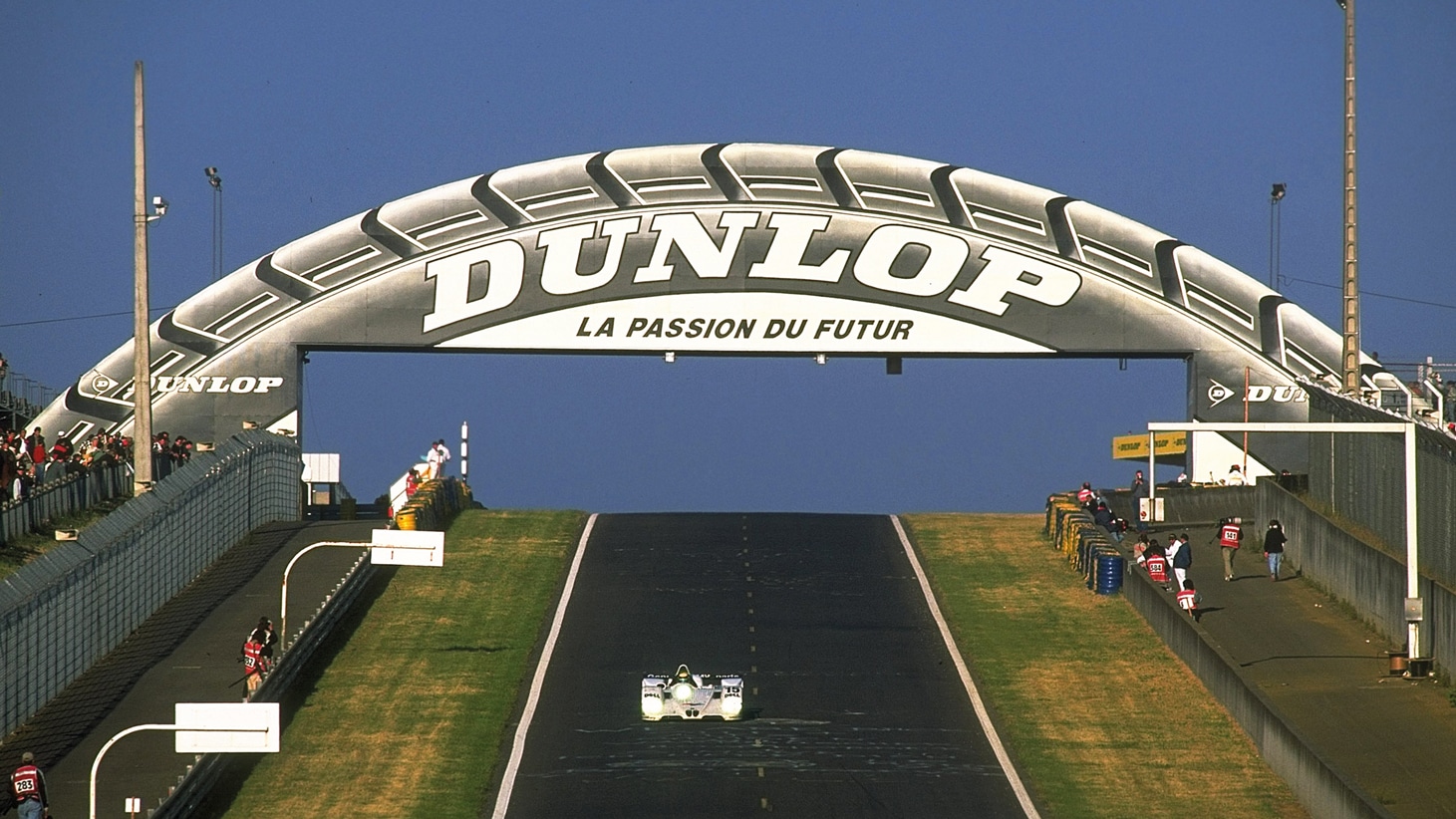
Dalmas, as the team leader in what BMW liked to called the ‘jockeys’ car’ in reference to the height of its drivers, had urged caution from his less-experienced team-mates, much to the chagrin of Berger.
“Berger was very angry, but I told him if we push, we break the car”
“Our strategy was to save the car – we were patient,” recalls Dalmas. “When I got in the car for the second time, Berger came on the radio telling me to push. I think the first two times I didn’t reply. In the garage afterwards he was very angry, but I told him if we push, we break the car.”
Martini also questioned his team-mate’s call for restraint. “Pierluigi kept asking me when he could push,” remembers Dalmas. “I said, ‘Wait, wait, your time will come.’”
And come it did in those dramatic final hours. Katayama belied the earlier pace of the Japanese-crewed GT-One by setting fastest lap of the race in his pursuit of the BMW. Who would have won if the battle had run its course will never be known. With just 50 minutes left on the clock, the Japanese driver was forced onto the kerbs at the first chicane on the Mulsanne Straight. By a BMW! The culprit was amateur driver Thomas Bscher in the reworked and privately run ’98 V12 LM.
The resulting puncture for the Toyota and the time lost in the pits to repair bodywork damaged by a flailing tyre resulted in an unrepresentative one-lap margin in BMW’s favour.
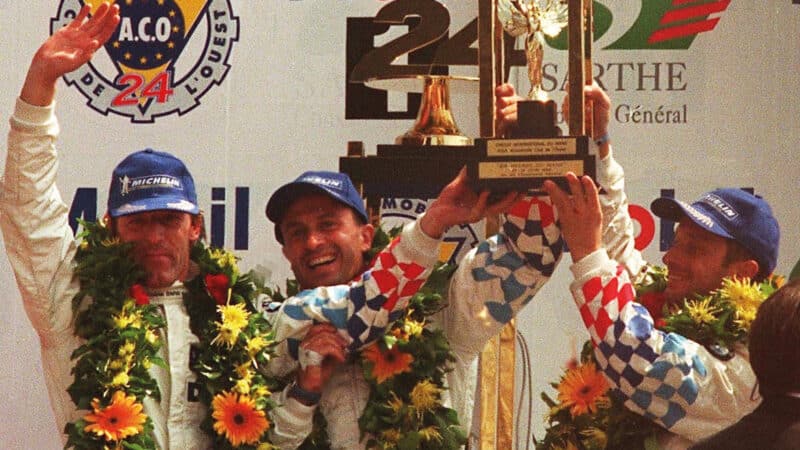
A fourth and final Le Mans win for Dalmas; a first and last for Winkelhock and Martini
BMW’s calculations suggested the V12 LMR would have come out of the pits 15sec ahead after the final round of stops, but Toyota had the quicker car at this crucial stage. It was convinced that it would have won. Hans Reiter, the engineer on the winning car, doesn’t disagree.
“I’d come to the realisation that they were going to catch us,” he recalls. “I was so nervous I couldn’t hold my pencil.”